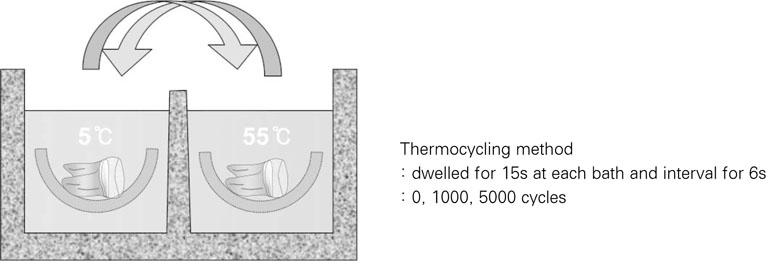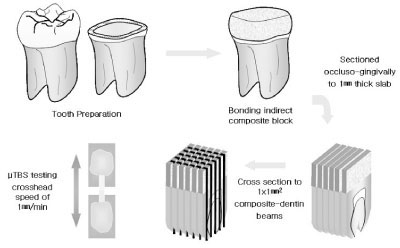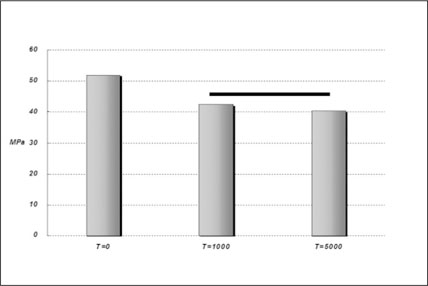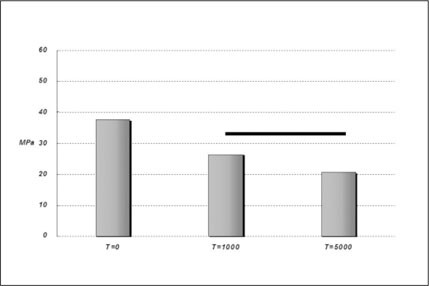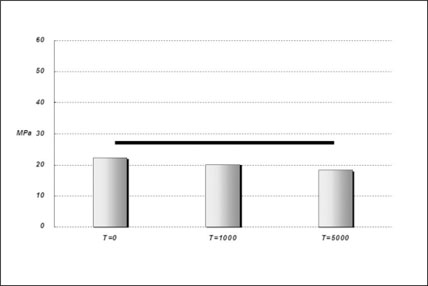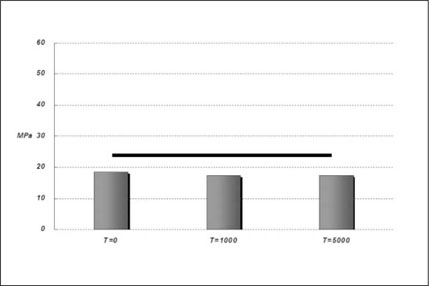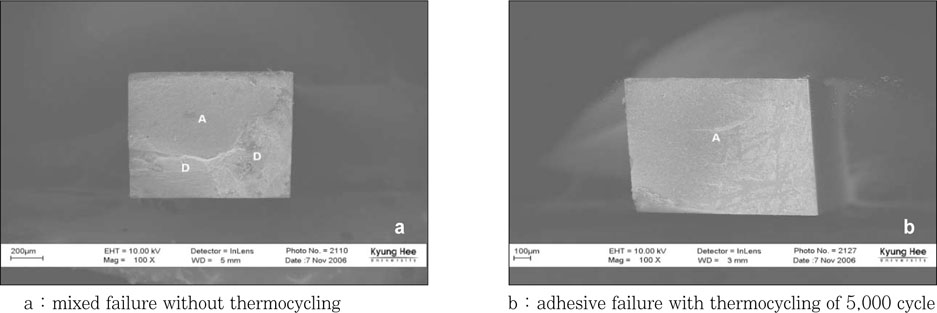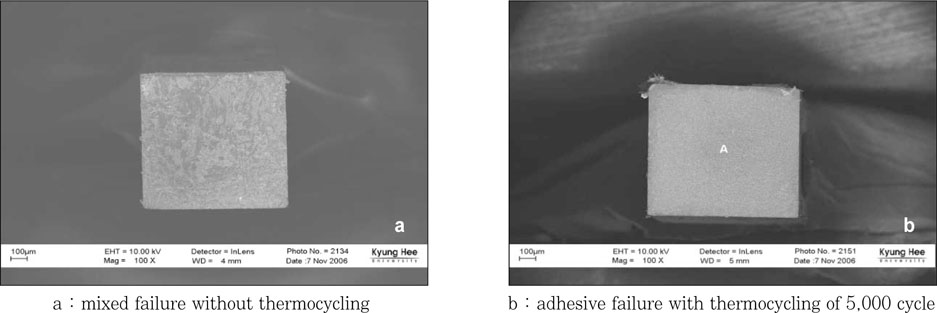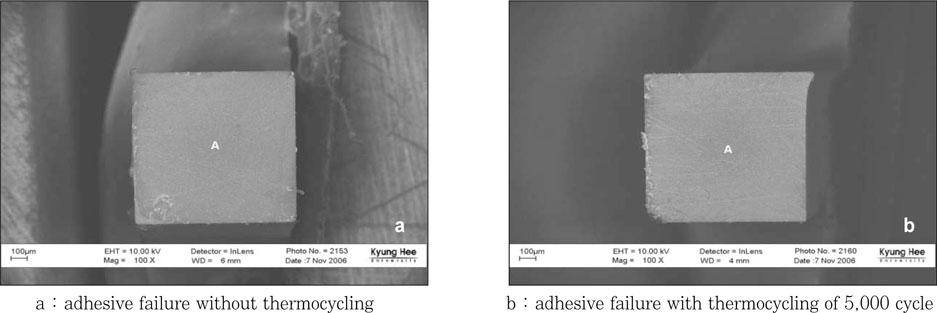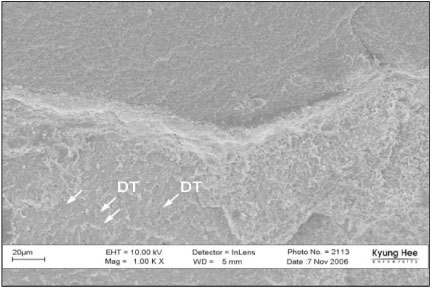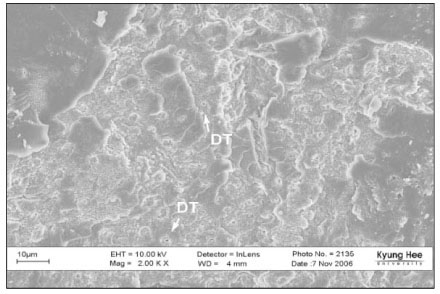The bonding durability of resin cements
- Affiliations
-
- 1Department of Conservative Dentistry, Division of Dentistry, Graduate of Kyung Hee University, Korea. choikkyu@khu.ac.kr
- KMID: 2175896
- DOI: http://doi.org/10.5395/JKACD.2007.32.4.343
Abstract
- The objectives of this study was to evaluate the durability of 4 resin cements by means of microtensile bond strength test combined with thermocycling method and fractographic FE-SEM analysis. Experimental groups were prepared according to thermocycling (0, 1,000, 5,000) and the kind of resin cements, those were Variolink II, Multilink, Panavia F 2.0, Rely X Unicem. Flat dentin surfaces were created on mid-coronal dentin of extracted third molars. Then fresh dentin surface was grounded with 320-grit silicon carbide abrasive papers to create uniform smear layers. Indirect composite block (Tescera, Bisco Inc., Schaumburg, IL, USA) was fabricated (12 x 12 x 6 mm3). It's surface for bonding to tooth was grounded with silicon carbide abrasive papers from 180- to 600-grit serially, then sandblasted with 20 - 50 microm alumina oxide. According to each manufacturer's instruction, dentin surface was treated and indirect composite block was luted on it using each resin cement. For Rely X Unicem, dentin surface was not treated. The bonded tooth-resin block were stored in distilled water at 37degrees C for 24 hours. After thermocycling, the bonded tooth-resin block was sectioned occluso-gingivally to 1.0 mm thick serial slabs using an Isomet slow-speed saw (Isomet, Buehler Ltd, Lake Bluff, IL, USA). These sectioned slabs were further sectioned to 1.0 x 1.0 mm2 composite-dentin beams. The specimens were tested with universal testing machine (EZ-Test, Shimadzu, Japan) at a crosshead speed of 1.0 mm/min with maximum load of 500 N. The data was analyzed using one-way ANOVA and Duncan's multiple comparison test at p < or = 0.05 level. Within the limited results, we conclude as follows; 1. The bond strength of Variolink II was evaluated the highest among experimental groups and was significantly decreased after 1,000 thermocycling (p < 0.05). 2. The bond strength of Multilink was more affected by thermocycling than the other experimental groups and significantly decreased after 1,000 thermocycling (p < 0.05). 3. Panavia F 2.0 and Rely X Unicem showed the gradually decreased tendency of microtensile bond strength according to thermocycling but there was no significant difference (p > 0.05). 4. Adhesive based-resin cements showed lower bond strength with or without thermocycling than composite based-resin cements. 5. Variolink II & Multilink showed high bond strength and mixed failure, which was occurred with a thin layer of luting resin cement before thermocycling and gradually increased adhesive failure along the dentin surface after thermocycling. The bonding performance of resin cement can be affected by application procedure and chemical composition. Composite based-resin cement showed higher bond strength and durability than adhesive based-resin cement.
MeSH Terms
Figure
Cited by 4 articles
-
Physical properties of different self-adhesive resin cements and their shear bond strength on lithium disilicate ceramic and dentin
Hye-Jin Shin, Chang-Kyu Song, Se-Hee Partk, Jin-Woo Kim, Kyung-Mo Cho
J Korean Acad Conserv Dent. 2009;34(3):184-191. doi: 10.5395/JKACD.2009.34.3.184.Effect of a desensitizer on dentinal bond strength in cementation of composite resin inlay
Sae-Hee Han, Young-Gon Cho
J Korean Acad Conserv Dent. 2009;34(3):223-231. doi: 10.5395/JKACD.2009.34.3.223.Effect of film thickness of resin cement on bonding efficiency in indirect composite restoration
Sang-Hyuck Lee, Gi-Woon Choi, Kyung-Kyu Choi
J Korean Acad Conserv Dent. 2010;35(2):69-79. doi: 10.5395/JKACD.2010.35.2.069.Effect of surface treatment of FRC-Post on bonding strength to resin cements
Chan-Hyun Park, Se-Hee Park, Jin-Woo Kim, Kyung-Mo Cho
J Korean Acad Conserv Dent. 2011;36(2):125-131. doi: 10.5395/JKACD.2011.36.2.125.
Reference
-
1. Manhart J, Scheibenbogen-Fuchsbrunner A, Chen HY, Hickel R. A 2-year clinical study of composite and ceramic inlays. Clin Oral Investig. 2000. 4:192–198.
Article2. Peumans M, Van Meerbeek B, Lambrechts P, Vanherle G. Porcelain Veneers; a review of the literature. J Dent. 2000. 28:163–177.
Article3. Mitchell CA, Abbariki M, Orr JF. The influence of luting cement on the probabilities of survival and modes of failure of cast full-coveraged crowns. Dent Mater. 2000. 16:198–206.
Article4. Knox J, Kralj B, Hübsch PF, Middleton J, Jones ML. An evaluation of the influence of orthodontic adhesive on the stresses generated in a bonded bracket finite element model. Am J Orthod Dentofacial Orthop. 2001. 119:43–53.
Article5. el-Mowafy O, Rubo MH. Retention of a posterior resin-bonded fixed partial denture with a modified design: an in vitro study. Int J Prosthodont. 2000. 13:425–431.6. Carvalho RM, Pegoraro TA, Tay FR, Pegoraro LF, Pashley DH. Adhesive permeability affects coupling of resin cements that utiliseself-etching primers to dentine. J Dent. 2004. 32:55–65.
Article7. Krämer N, Lohbauer U, Frankenberger R. Adhesive luting of indirect restorations. Am J Dent. 2000. 13:60D–76D.8. Hasegawa EA, Boyer DB, Chan DC. Hardening of dual-cured cements under composite resin inlays. J Prosthet Dent. 1991. 66:187–192.
Article9. el-Badrawy WA, el-Mowafy OM. Chemical versus dual curing of resin inlay cements. J Prosthet Dent. 1995. 73:515–524.
Article10. Pimenta LA, Amaral CM, Bedran de Castro AK, Ritter AV. Stability of dentin bond strengths using different bonding techniques after 12 months: total-etch, deproteinization and self-etching. Oper Dent. 2004. 29:592–598.11. Paul SJ, Welter DA, Ghazi M, Pashley D. Nanoleakage at the dentin adhesivevs. microtensile bond strength. Oper Dent. 1999. 24:181–188.12. Giannini M, Seixas CA, Reis AF, Pimenta LA. Six-month storage-time evaluation of one-bottle adhesive systems to dentin. J Esthet Restor Dent. 2003. 15:43–49.
Article13. Tay FR, Pashley DH, Yoshiyama M. Two mondes of nanoleakage expression in single-step adhesives. J Dent Res. 2002. 81:472–476.
Article14. Sano H, Yoshikawa T, Pereira PNR, Kanemura N, Morigami M, Tagami J, Pashley D. Long-term Durability of dentine bonds made with a self-etching primer. J Dent Res. 1999. 78:906–911.
Article15. Kato G, Nakabayashi N. The durability of adhesion to phosphoric acid etched,wet dentine substrates. Dent Mater. 1998. 14:347–352.
Article16. Hakimeh S, Vaidyanathan J, Houpt ML, Vaidyanathan TK, Hagen SV. Microleakage of compomer class V restorations: effect of load cycling, thermal cycling, and cavity shape differences. J Prosthet Dent. 2000. 83:194–203.
Article17. Wendt SL, Mcinnes PM, Dickinson GL. The effect of thermocycling in microleakage analysis. Dent Mater. 1992. 8:181–184.
Article18. Miyazaki M, Sato M, Onose H, Moore BK. Influence of thermal cycling on dentin bond strength of two-step bonding systems. Am J Dent. 1998. 11:118–122.19. Hashimoto M, Ohno H, Kaga M, Endo K, Sano H, Oguchi H. In vivo degradation of resin-dentin bonds in humans over 1 to 3 years. J Dent Res. 2000. 79:1385–1391.
Article20. Krejci I, Lutz F. Mixed class V restorations: the potentials of dentine bonding. J Dent. 1990. 18:263–270.21. Suh BI, Feng L, Pashley DH, Tay FR. Factors contributing to the incompatibility between simplified-step adhesives and chemically-cured or dual-cured composites. Part III. Effect of acidic resin monomers. J Adhes Dent. 2003. 5:267–282.22. Attal JP, Asmussen E, Degrange M. Effects of surface treatment on the free surface energy of dentin. Dent Mater. 1994. 10:259–264.
Article23. Tay FR, Pashley DH. Aggressiveness of contemporary self-etching systems. I: Depth of penetration beyond dentin smear layers. Dent Mater. 2001. 17:296–308.24. Frankenberger R, Strobel WO, Lohbauer U, Krämer N, Petschelt A. The effect of six years of water storage on resin composite bonding to human dentin. J Biomed Mater Res B Appl Biomater. 2004. 69:25–32.
Article25. Armstrong SR, Vargas MA, Fang Q, Laffoon JE. Microtensile bond strength of a total-etch 3-step, total-etch 2-step, self-etch 2-step, and a self-etch 1-step dentin bonding system through 15-month water storage. J Adhes Dent. 2003. 5:47–56.26. Tay FR, Pashley DH. Dental adhesives of the future. J Adhes Dent. 2002. 4:91–103.27. Brackett MG, Dib A, Brackett WW, Estrada BE, Reyes AA. One-year clinical performance of a resin-modified glass ionomer and a resin composite restorative material in unprepared Class V restorations. Oper Dent. 2002. 27:112–116.28. Türkün SL. Clinical evaluation of a self-etching and a one-bottle adhesive system at two years. J Dent. 2003. 31:527–534.
Article29. Takahashi A, Inoue S, Kawamoto C, Ominato R, Tanaka T, Sato Y, Pereira PNR, Sano H. In vivo long-term durability of the bond to dentin using two adhesive systems. J Adhes Dent. 2002. 4:151–159.30. Miyazaki M, Sato M, Onose H, Moore BK. Influence of thermal cycling on dentin bond strength of two-step bonding systems. Am J Dent. 1998. 11:118–122.31. Nikaido T, Kunzelman KH, Chen H, Ogata M, Harada N, Yamaguchi S, Cox CF, Hickel R, Tagami J. Evaluation of thermal cycling and mechanical loading on bond strength of a self-etching primer system to dentin. Dent Mater. 2002. 18:269–275.
Article32. De Munck J, Vargas M, Van Landuyt K, Hikita K, Lambrechts P, Van Meerbeek B. Bonding of an auto-adhesive luting material to enamel and dentin. Dent Mater. 2004. 20:963–971.
Article33. Yang B, Ludwig K, Adelung R, Kern M. Microtensile bond strength of three luting resins to human regional dentin. Dent Mater. 2006. 22:45–46.
Article34. Kim DW, Park SJ, Choi KK. Compatibility of self-etching dentin adhesives with resin luting cements. J Korean Acad Conserv Dent. 2005. 30:493–504.
Article
- Full Text Links
- Actions
-
Cited
- CITED
-
- Close
- Share
- Similar articles
-
- The effect of repeated bonding on the shear bond strength of different resin cements to enamel and dentin
- The effect of bonding resin on bond strength of dual-cure resin cements
- Bonding between resin and ceramics
- Effect of film thickness of resin cement on bonding efficiency in indirect composite restoration
- Microtensile bond strength of self-etching and self-adhesive resin cements to dentin and indirect composite resin

